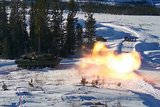US Army to increase investments in missile capabilities by 62% in FY2025
The service plans to acquire 230 PRSM units in FY2025, which marked a 110% increase compared to the FY2024 request. (Photo: Lockheed Martin)
The US Army announced this week a $185.9 billion budget proposal to cover its activities over the FY2025. While the request reduced resources for the purchase of aircraft, weapons and tracked combat vehicles, it increased funds for missile capabilities by 62% compared to the FY2024 proposition (with continuing resolution adjustments).
The total amount allocated to missiles for the next fiscal year will be $6.2 billion and comprised additional funds for several programmes including the Precision Strike Missile (PRSM), Mid-Range Capability (MRC), Long-Range Hypersonic Weapon, Javelin anti-tank weapons and Guided MLRS Rocket (GMLRS).
Gabe Camarillo, under secretary of the US Army,
Already have an account? Log in
Want to keep reading this article?
More from Land Warfare
-
![2025 land market review: British Army woes, European heavy armour and US MBT progress]()
2025 land market review: British Army woes, European heavy armour and US MBT progress
The last year has seen several major procurements in the land market. Shephard’s Dr Peter Magill reviews the main trends and themes in land procurement of 2025.
-
![Hungary set to begin using Hero 400 loitering munitions]()
Hungary set to begin using Hero 400 loitering munitions
Developed by Israel's Uvision and with systems being sold in the thousands to multiple European NATO countries and the US, the Hero family of loitering systems is also in production in the US and Italy, the latter through Rheinmetall.
-
![Croatia orders Leopards and CAESAR howitzers as Lithuania orders more CAESARs]()
Croatia orders Leopards and CAESAR howitzers as Lithuania orders more CAESARs
The Leopard is becoming the tank of choice in central and eastern Europe as Croatia joins Lithuania, the Czech Republic and Hungary in ordering the platform. Lithuania and Croatia have also signed for CAESAR howitzers.
-
![Light Reconnaissance Strike – enabling a vital mission set (Studio)]()
Light Reconnaissance Strike – enabling a vital mission set (Studio)
A new system-of-systems concept will unlock digital integration of sensors and weapons for Light Forces, allowing them to shape the battlefield environment on their own terms and upgrade legacy platforms.

























